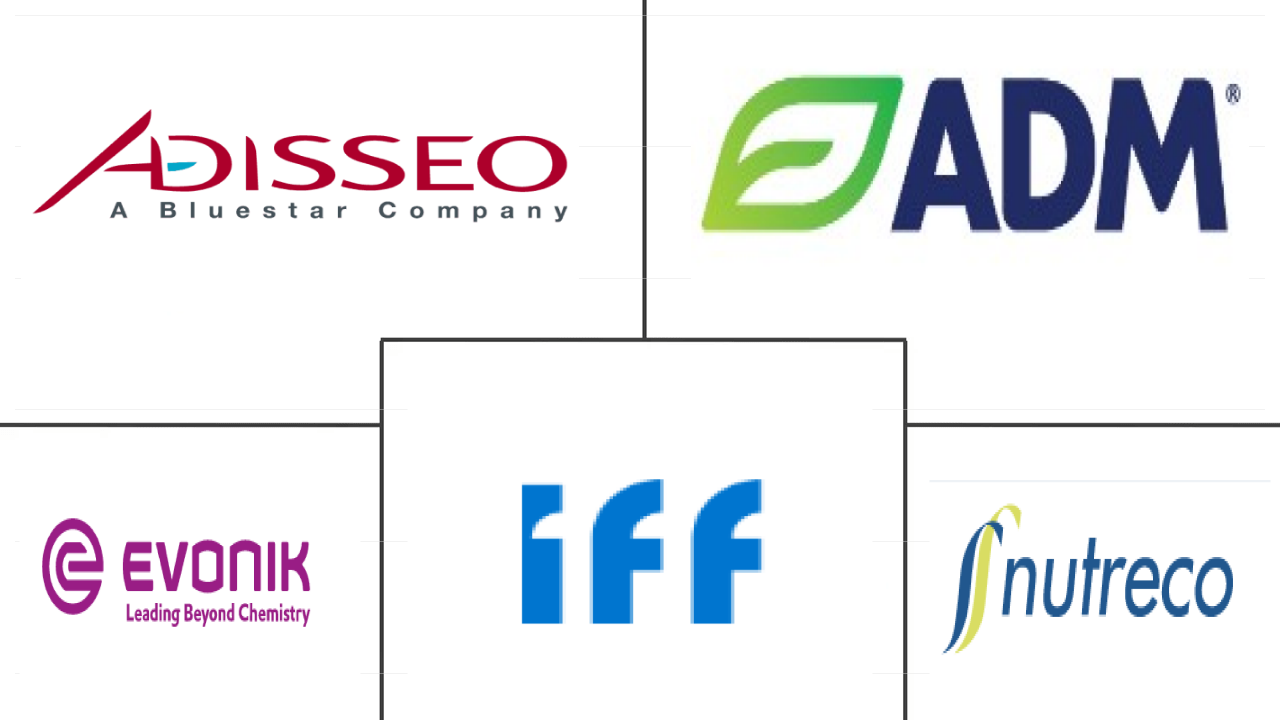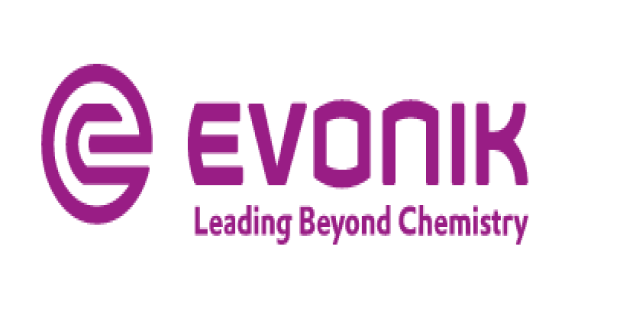Market Size of feed amino acids Industry
| Icons | Lable | Value |
|---|---|---|
|
|
Study Period | 2017 - 2029 |
|
|
Market Size (2024) | USD 8.00 Billion |
|
|
Market Size (2029) | USD 10.20 Billion |
|
|
Largest Share by Sub Additive | Lysine |
|
|
CAGR (2024 - 2029) | 4.99 % |
|
|
Largest Share by Region | Asia-Pacific |
|
|
Market Concentration | Medium |
Major Players |
||

|
||
|
*Disclaimer: Major Players sorted in no particular order |
Feed Amino Acids Market Analysis
The Feed Amino Acids Market size is estimated at 8.00 billion USD in 2024, and is expected to reach 10.20 billion USD by 2029, growing at a CAGR of 4.99% during the forecast period (2024-2029).
8.00 Billion
Market Size in 2024 (USD)
10.20 Billion
Market Size in 2029 (USD)
5.38 %
CAGR (2017-2023)
4.99 %
CAGR (2024-2029)
Largest Market by Sub-Additive
35.90 %
value share, Lysine, 2023
Lysine is the largest segment in the global market due to its importance in increasing efficiency characteristics such as improved gut health and easy animal digestion.
Largest Market by Region
30.36 %
value share, Asia-Pacific, 2023
The Asia-Pacific region is the largest segment as it has the highest poultry and ruminants population, increased feed production and high demand for poultry products.
Fastest-growing Market by Sub-Additive
5.36 %
Projected CAGR, Methionine, 2024-2029
Methionine has witnessed the fastest growth because it helps increase protein and milk content in cattle, improves gut health and makes animal digestion easy.
Fastest-growing Market by Region
5.66 %
Projected CAGR, North America, 2024-2029
The increase in the demand for meat and livestock products and feed production has helped the North American market become the fastest-growing region globally.
Leading Market Player
12.71 %
market share, Evonik Industries AG, 2022

Evonik is the market leader as it has expanded its manufacturing facility in the United States and partnerships with regional players in the United States, Canada, and China.
- The global feed additives market continues to experience significant growth, with amino acids accounting for 22.1% of the market value in 2022. As the building blocks of proteins, amino acids play a crucial role in animal health and productivity.
- Lysine emerged as the largest segment in 2022, accounting for a market share of 7.9% in the global feed additives market. This can be attributed to its ability to improve gut health and aid digestion, leading to increased animal efficiency.
- Methionine was another essential feed amino acid, accounting for USD 2.2 billion in 2022. It is in high demand due to its ability to regulate metabolic processes and improve digestive functioning and gut health. It is a key driver of increased meat productivity in animals.
- Poultry was the largest animal type in the feed amino acid market, accounting for 43.9% of the total market value in 2022. This trend is expected to continue, with a projected CAGR of 5.1% during the forecast period. The growth is driven by the increased focus on animal health, productivity, and the growing demand for meat products globally.
- Europe was the largest region in the global feed amino acids market, holding a market share of 29.2%. This can be attributed to the higher production of feed in European countries, which was about 262.9 million metric tons in 2022. The growth rate for all feed amino acid types in the region is expected to be similar during the forecast period, driven by their benefits and applications across all animal types.
- The growth is primarily driven by the benefits of feed amino acids, including improved gut health, muscle development, and egg formation. With the continued focus on animal health and productivity, the demand for feed amino acids is expected to remain strong in the future.
- The global market for feed amino acids experienced significant growth, valued at USD 2.20 billion, primarily in the Asia-Pacific region. From 2017 to 2022, the market increased by more than 51.7% due to the rapidly developing livestock industry and increased regional demand for meat and meat products. The Asia-Pacific region is the fastest-growing market globally, and it is expected to register a CAGR of 5.0% during the forecast period (2023-2029).
- The high consumption of feed amino acids in 2022 was primarily due to increased livestock farming, which boosted feed production in the Asia-Pacific region. This growth was driven by major developing markets such as China, India, Australia, and Japan, with a combined total of 17.25 billion animal heads, accounting for 51.7% of the global market.
- Europe and North America are other major regions, accounting for a market share of 50.6% globally in 2022. The North American region experienced significant growth, with feed production increasing by 30.2% from 215.5 million metric tons in 2017. The United States and China accounted for the largest market shares, with 17.0% and 9.9% in 2022, respectively.
- The global market for feed amino acids is driven by the rising livestock production for the consumption of meat and dairy products and the expansion of the livestock industry. The increasing usage of dietary additives that provide health benefits to animals is expected to boost the growth of the market, registering a CAGR of 5.0% during the forecast period (2023-2029).
Feed Amino Acids Industry Segmentation
Lysine, Methionine, Threonine, Tryptophan are covered as segments by Sub Additive. Aquaculture, Poultry, Ruminants, Swine are covered as segments by Animal. Africa, Asia-Pacific, Europe, Middle East, North America, South America are covered as segments by Region.
- The global feed additives market continues to experience significant growth, with amino acids accounting for 22.1% of the market value in 2022. As the building blocks of proteins, amino acids play a crucial role in animal health and productivity.
- Lysine emerged as the largest segment in 2022, accounting for a market share of 7.9% in the global feed additives market. This can be attributed to its ability to improve gut health and aid digestion, leading to increased animal efficiency.
- Methionine was another essential feed amino acid, accounting for USD 2.2 billion in 2022. It is in high demand due to its ability to regulate metabolic processes and improve digestive functioning and gut health. It is a key driver of increased meat productivity in animals.
- Poultry was the largest animal type in the feed amino acid market, accounting for 43.9% of the total market value in 2022. This trend is expected to continue, with a projected CAGR of 5.1% during the forecast period. The growth is driven by the increased focus on animal health, productivity, and the growing demand for meat products globally.
- Europe was the largest region in the global feed amino acids market, holding a market share of 29.2%. This can be attributed to the higher production of feed in European countries, which was about 262.9 million metric tons in 2022. The growth rate for all feed amino acid types in the region is expected to be similar during the forecast period, driven by their benefits and applications across all animal types.
- The growth is primarily driven by the benefits of feed amino acids, including improved gut health, muscle development, and egg formation. With the continued focus on animal health and productivity, the demand for feed amino acids is expected to remain strong in the future.
| Sub Additive | |
| Lysine | |
| Methionine | |
| Threonine | |
| Tryptophan | |
| Other Amino Acids |
| Animal | |||||||
| |||||||
| |||||||
| |||||||
| Swine | |||||||
| Other Animals |
| Region | ||||||||||||||
| ||||||||||||||
| ||||||||||||||
| ||||||||||||||
| ||||||||||||||
| ||||||||||||||
|
Feed Amino Acids Market Size Summary
The Feed Amino Acids Market is experiencing robust growth, driven by the increasing demand for animal health and productivity enhancements. Amino acids, as essential components of proteins, are pivotal in improving gut health, muscle development, and overall animal efficiency. Lysine and methionine are among the most significant segments, with lysine being particularly valued for its digestive benefits and methionine for its role in metabolic regulation. The poultry sector dominates the market, reflecting a sustained demand for poultry products globally. This trend is supported by the rising consumption of chicken meat and eggs, influenced by the increasing prices of alternative meats like pork. The Asia-Pacific region stands out as the fastest-growing market, propelled by the expanding livestock industry and heightened demand for meat and seafood products.
The global market landscape is moderately consolidated, with major players like Adisseo, Archer Daniel Midland Co., Evonik Industries AG, IFF (Danisco Animal Nutrition), and SHV (Nutreco NV) leading the charge. Strategic expansions and partnerships, such as Evonik's collaboration with BASF and Adisseo's new methionine plant in China, underscore the industry's focus on enhancing production capabilities and reducing environmental impacts. The aquaculture sector also contributes significantly to market growth, with increased fish and shrimp feed production addressing the rising global seafood demand. Regions like South America are witnessing substantial feed production increases, further bolstering the market's expansion. Overall, the Feed Amino Acids Market is poised for continued growth, driven by the dual forces of livestock and aquaculture industry developments.
Feed Amino Acids Market Size - Table of Contents
-
1. MARKET SEGMENTATION (includes market size in Value in USD and Volume, Forecasts up to 2029 and analysis of growth prospects)
-
1.1 Sub Additive
-
1.1.1 Lysine
-
1.1.2 Methionine
-
1.1.3 Threonine
-
1.1.4 Tryptophan
-
1.1.5 Other Amino Acids
-
-
1.2 Animal
-
1.2.1 Aquaculture
-
1.2.1.1 By Sub Animal
-
1.2.1.1.1 Fish
-
1.2.1.1.2 Shrimp
-
1.2.1.1.3 Other Aquaculture Species
-
-
-
1.2.2 Poultry
-
1.2.2.1 By Sub Animal
-
1.2.2.1.1 Broiler
-
1.2.2.1.2 Layer
-
1.2.2.1.3 Other Poultry Birds
-
-
-
1.2.3 Ruminants
-
1.2.3.1 By Sub Animal
-
1.2.3.1.1 Beef Cattle
-
1.2.3.1.2 Dairy Cattle
-
1.2.3.1.3 Other Ruminants
-
-
-
1.2.4 Swine
-
1.2.5 Other Animals
-
-
1.3 Region
-
1.3.1 Africa
-
1.3.1.1 By Country
-
1.3.1.1.1 Egypt
-
1.3.1.1.2 Kenya
-
1.3.1.1.3 South Africa
-
1.3.1.1.4 Rest of Africa
-
-
-
1.3.2 Asia-Pacific
-
1.3.2.1 By Country
-
1.3.2.1.1 Australia
-
1.3.2.1.2 China
-
1.3.2.1.3 India
-
1.3.2.1.4 Indonesia
-
1.3.2.1.5 Japan
-
1.3.2.1.6 Philippines
-
1.3.2.1.7 South Korea
-
1.3.2.1.8 Thailand
-
1.3.2.1.9 Vietnam
-
1.3.2.1.10 Rest of Asia-Pacific
-
-
-
1.3.3 Europe
-
1.3.3.1 By Country
-
1.3.3.1.1 France
-
1.3.3.1.2 Germany
-
1.3.3.1.3 Italy
-
1.3.3.1.4 Netherlands
-
1.3.3.1.5 Russia
-
1.3.3.1.6 Spain
-
1.3.3.1.7 Turkey
-
1.3.3.1.8 United Kingdom
-
1.3.3.1.9 Rest of Europe
-
-
-
1.3.4 Middle East
-
1.3.4.1 By Country
-
1.3.4.1.1 Iran
-
1.3.4.1.2 Saudi Arabia
-
1.3.4.1.3 Rest of Middle East
-
-
-
1.3.5 North America
-
1.3.5.1 By Country
-
1.3.5.1.1 Canada
-
1.3.5.1.2 Mexico
-
1.3.5.1.3 United States
-
1.3.5.1.4 Rest of North America
-
-
-
1.3.6 South America
-
1.3.6.1 By Country
-
1.3.6.1.1 Argentina
-
1.3.6.1.2 Brazil
-
1.3.6.1.3 Chile
-
1.3.6.1.4 Rest of South America
-
-
-
-
Feed Amino Acids Market Size FAQs
How big is the Global Feed Amino Acids Market?
The Global Feed Amino Acids Market size is expected to reach USD 8.00 billion in 2024 and grow at a CAGR of 4.99% to reach USD 10.20 billion by 2029.
What is the current Global Feed Amino Acids Market size?
In 2024, the Global Feed Amino Acids Market size is expected to reach USD 8.00 billion.

